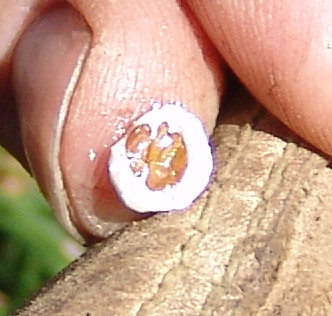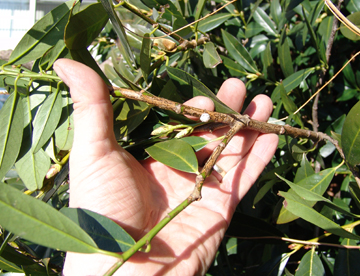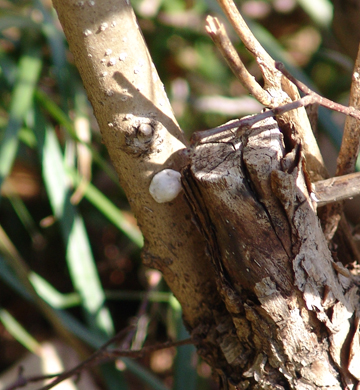Now is a good time of year to scout your trees and shrubs for insects because there is no foliage present to hide insects living on the stems or branches. An insect not known to survive Pennsylvania winters, except for the Philadelphia region, is Indian wax scale, Ceroplastes ceriferus. Bill Costello, IPM coordinator, has been seeing these insects on Callicapra and cherry laurel in the John W. Nason Garden for the past three years. For the first time this year, he found them on Japanese maples outside of the Harry Wood Garden.
Found mostly on shrubs in the North as opposed to tree infestations in the South, Indian wax scale looks like someone stuck their white chewing gum in the crouch of the plant’s stems. If you remove the “gum” the underside of the scale is pink or red. The white substance is the wax the insect secretes to protect its body. The pink or red underside is the actual scale. Scale most often chooses hollies, euonymus, boxwood, pyracantha, and Viburnum as its hosts in Pennsylvania.
Indian wax scale feeds by extracting sap from the vascular system. A heavy infestation can cause premature leaf drop and branch dieback as well as producing large quantities of honeydew. These quantities of honeydew encourage black sooty mold which renders the plant and surrounding area unsightly.
During this time of year the best control is mechanical. Simply remove the scale from your plants with your hands. The females overwinter to produce eggs in May. Bill has identified several plants to leave the population in place to monitor their development. Once the monitored population begins its emergence period, he will apply horticultural oils to attack the newly hatched crawlers. This is when the insect is most vulnerable. Because of an extended emergence period (2 to 3 weeks), it is important to apply oils throughout this time period.
Good IPM practices require monitoring of your plants. Be sure to take a moment the next time you are working in the garden to inspect your plants for insects and diseases.



